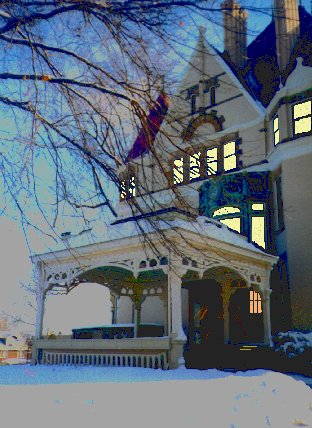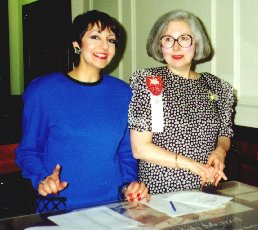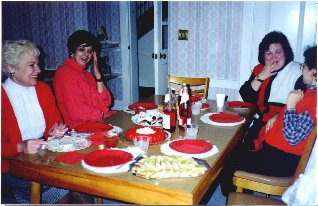
 |
 It was a wonderful party!
It was a wonderful party! The most memorable and and elegant Valentine's party ever, a fund-raiser for Pittsburgh's classical music station, and held on the grounds of the Frick estate in Point Breeze. A snowy February night, wet, heavy snow where the flakes clumped together, landing on the guest's heads and shoulders as they made their way in from the parking lot, looking and feeling like characters straight from a Victorian novel. The party began in the Frick Museum, which was built by Helen Clay Frick to hold her collection of European art. Oh, there is a story around it as well: she had built a beautiful Italianate building in Oakland for her art collection, and was going to donate it all to the University, but then there had been some sort of disagreement, and she had withdrawn her collection and built this museum for it on the grounds of her own estate. We were greeted at the door by members of the radio staff: Kweilin Nassar, who we have known since she was a teenager growing up in Baldwin and the then station manager, Cici Summers. Quick as a flash, I took their picture. "No, no, mustn't do that! No photography allowed! It is part of our contract!" said Cici. Kweilin said nothing; she knows that I take pictures of everything I do, everywhere I go! But I put the camera back in my pocket and promised to take no more. I am constantly thwarted this way - but here it is, the only picture from that wonderful party! Tables were set up in the main room of the museum. On them, a large variety of elegant foods, including watercress sandwiches, salmon, baked brie; fancy bread, and much, much more. With a light wine to wash it all down. . A string trio played while we nibbled these foods and walked in the galleries, looking at the 17th and 18th century Flemish paintings. And then, desserts - petits fours and other small tarts, and coffee. It could not have been more elegant! I felt like a millionaire! |
 And then we were escorted in small groups to the mansion for a tour. Clayton was built in the 1880s by Henry Clay Frick as a first home for his young family. Walking through the beautifully furnished Victorian rooms, one gets the sense of the well heeled, close knit family that once lived in them. In the library/reading room, there are board games waiting for the children to play, books for their parents, writing desk where Mrs. Frick kept up with correspondence. In the children's bedrooms, toys wait for little hands to pick them up. Throughout the mansion are paintings and photographs of Martha, the first born daughter who died at the age of 6 and was mourned by her father for the rest of his life.
And then we were escorted in small groups to the mansion for a tour. Clayton was built in the 1880s by Henry Clay Frick as a first home for his young family. Walking through the beautifully furnished Victorian rooms, one gets the sense of the well heeled, close knit family that once lived in them. In the library/reading room, there are board games waiting for the children to play, books for their parents, writing desk where Mrs. Frick kept up with correspondence. In the children's bedrooms, toys wait for little hands to pick them up. Throughout the mansion are paintings and photographs of Martha, the first born daughter who died at the age of 6 and was mourned by her father for the rest of his life. The late 1800s was a time when Pittsburgh was home to many millionaires, among them Andrew Carnegie, the Scaiffes, the Mellons, Henry Heinz, George Westinghouse - and the Fricks. Money was to be made from the steel mills, the railroads, the banks. The flood of immigrants from Eastern Europe who worked in the mills and on the railroads did not benefit from the boom as their bosses did. 1892 was the year of the infamous "Homestead Strike" and it was Henry Clay Frick who ordered the Pinkertons to come down the river on a barge and fire on the strikers - an action which broke the strike. (For many Pittsburghers, grandchildren and great-grandchildren of the strikers, Henry Clay Frick is still roundly detested.) In 1905 he moved his family to New York. He did not return, but his daughter, Helen Clay Frick, loved the place and came back often, and spent her final years in Pittsburgh. She died in 1984 at the age of 96 and left her money to a foundation to restore the mansion. The restoration was finished in 1990, and the mansion opened to the public, a tribute of a daughter in honor of her father. She wanted to erase the picture of the ruthless businessman, and replace it with that of the loving father, caring husband, cultured gentleman that she knew him to be. On the Frick property are, besides the mansion and the art museum, a carriage house - a museum of beautifully restored antique cars, a greenhouse, giftshop and a cafe. Entry to the museum and the carriage house is free to all; there is a charge to tour the mansion and reservations are required. Members of Clayton can tour the mansion for free, and only members can make lunch reservations at the cafe. |
 I worked for many years at the School for the Deaf which is only a couple of miles from Clayton and had a close circle of friends who also worked there. On Fridays, when the students left at noon, and the staff at 2, the cafe was often our destination, and we'd take a late lunch there. Of my friends, only Marina was a member of Clayton, and on her shoulders fell the task of making our reservations. And a number of times, when there was something special to see (such as the holiday decorations) we would stay and take an afternoon tour of the mansion. We all knew it well.
I worked for many years at the School for the Deaf which is only a couple of miles from Clayton and had a close circle of friends who also worked there. On Fridays, when the students left at noon, and the staff at 2, the cafe was often our destination, and we'd take a late lunch there. Of my friends, only Marina was a member of Clayton, and on her shoulders fell the task of making our reservations. And a number of times, when there was something special to see (such as the holiday decorations) we would stay and take an afternoon tour of the mansion. We all knew it well. Several years later, in early February, Marina learned of the cancer that eventually killed her. All her friends gathered around, and planned events to help take her mind off the awful therapies she was about to undergo. One afternoon, we made an elegant little lunch for her - not at Clayton, but we drew on the menu and the ambiance. It was a Valentine's luncheon, with watercress sandwiches, and cucumber and lemon pepper sandwiches, too. Some brie, although not baked. A strawberry jello mold, and sparkling fruit drinks. The table covering and plates were coordinated, and we all wore red. |
 These three things have always been entwined in my memory: Marina, elegance, and the Clayton Estate.
These three things have always been entwined in my memory: Marina, elegance, and the Clayton Estate. And as Valentine's Day is the time we send messages to our loved ones, I send this web page out on the ether, in memory of my friend Marina. |